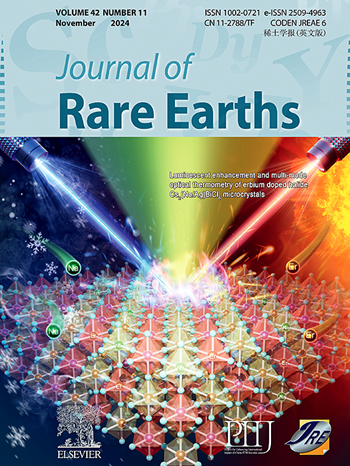High capacitive rare-earth co-doped transition metal/graphene oxide composites as effective electrode material for supercapacitors
IF 7.2
1区 化学
Q1 CHEMISTRY, APPLIED
引用次数: 0
Abstract
In recent times, there has been a surge of attention towards advanced high-performance materials for storing energy, specifically in supercapacitors. One encouraging method involves utilizing nanocomposites based on transition metal oxides/graphene which have demonstrated significant potential for improving capacitance. The electrochemical properties of titanium oxide doped graphene in current research have been improved through the incorporation of rare earth metals. The hydrothermal technique was chosen for the fabrication of nanocomposites as electrode materials. X-ray diffraction (XRD), Raman spectroscopy, Fourier transform infrared spectroscopy (FT-IR), and scanning electron microscopy (SEM) approaches were employed for the characterization of nanocomposites. Ternary and quaternary nanocomposites with 2 wt% rare earth elements doped with titanium oxide and graphene were synthesized with various ratios of lanthanum and cerium as dopants. In 2 wt% La:Ce-TiO2/rGO, lanthanum, and cerium were doped in 1:1, 1:3, and 1:5 ratios. 2 wt% La:Ce(1:5)-TiO2/rGO among co-doped composites exhibits better capacitive performance as determined through cyclic voltammetry and galvanostatic charge–discharge. Among all the nanocomposites 422 F/g was the maximum depicted by 2 wt% La:Ce(1:5)-TiO2/rGO at a scan rate of 10 mV/s (potential window from −0.4 to +0.6 V) and 1895 F/g at 1 mV/s (potential window −0.6 to +0.6 V). specific capacitance was also determined via GCD, and a maximum capacitance of 486 F/g is depicted by 2 wt% La:Ce(1:5)-TiO2/rGO. The same composites have also served as promising electrode materials in terms of columbic efficiency, power, and energy density.

高电容性稀土共掺杂过渡金属/氧化石墨烯复合材料作为超级电容器的有效电极材料
近年来,人们对用于存储能量的先进高性能材料,特别是超级电容器的关注激增。一种令人鼓舞的方法是利用基于过渡金属氧化物/石墨烯的纳米复合材料,这已经证明了提高电容的巨大潜力。目前研究的氧化钛掺杂石墨烯的电化学性能通过稀土金属的掺入得到了改善。采用水热技术制备纳米复合材料作为电极材料。采用x射线衍射(XRD)、拉曼光谱(Raman spectroscopy)、傅里叶变换红外光谱(FT-IR)和扫描电镜(SEM)等方法对纳米复合材料进行表征。以不同比例的镧和铈为掺杂剂,在氧化钛和石墨烯中掺杂2 wt%稀土元素,合成了三元和四元纳米复合材料。在2 wt%的La:Ce-TiO2/rGO中,镧和铈以1:1、1:3和1:5的比例掺杂。通过循环伏安法和恒流充放电测试,发现2 wt% La:Ce(1:5)-TiO2/rGO共掺杂复合材料具有更好的电容性能。在所有纳米复合材料中,2 wt% La:Ce(1:5)-TiO2/rGO在扫描速率为10 mV/s(电位窗口从- 0.4到+0.6 V)时最大可描绘422 F/g, 1 mV/s(电位窗口从- 0.6到+0.6 V)时最大可描绘1895 F/g。通过GCD测定了比电容,2 wt% La:Ce(1:5)-TiO2/rGO描绘了最大电容486 F/g。同样的复合材料在哥伦比亚效率、功率和能量密度方面也被用作有前途的电极材料。
本文章由计算机程序翻译,如有差异,请以英文原文为准。
求助全文
约1分钟内获得全文
求助全文
来源期刊

Journal of Rare Earths
化学-应用化学
CiteScore
8.70
自引率
14.30%
发文量
374
审稿时长
1.7 months
期刊介绍:
The Journal of Rare Earths reports studies on the 17 rare earth elements. It is a unique English-language learned journal that publishes works on various aspects of basic theory and applied science in the field of rare earths (RE). The journal accepts original high-quality original research papers and review articles with inventive content, and complete experimental data. It represents high academic standards and new progress in the RE field. Due to the advantage of abundant RE resources of China, the research on RE develops very actively, and papers on the latest progress in this field emerge every year. It is not only an important resource in which technicians publish and obtain their latest research results on RE, but also an important way of reflecting the updated progress in RE research field.
The Journal of Rare Earths covers all research and application of RE rare earths including spectroscopy, luminescence and phosphors, rare earth catalysis, magnetism and magnetic materials, advanced rare earth materials, RE chemistry & hydrometallurgy, RE metallography & pyrometallurgy, RE new materials, RE solid state physics & solid state chemistry, rare earth applications, RE analysis & test, RE geology & ore dressing, etc.
 求助内容:
求助内容: 应助结果提醒方式:
应助结果提醒方式:


